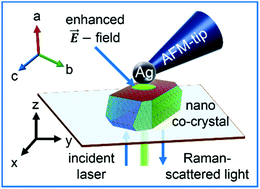Surface characterization of nanoscale co-crystals enabled through tip enhanced Raman spectroscopy†
Abstract
Atomic Force Microscopy coupled with Tip Enhanced Raman Spectroscopy (AFM-TERS) was applied to obtain information about the structure and surface composition of single nano co-crystals. For this purpose, a co-crystalline system consisting of 2,4,6,8,10,12-hexanitro-2,4,6,8,10,12-hexaazatetracyclo-[5.5.0.03,11.05,9]-dodecane (CL-20) and 1,3,5,7-tetranitro-1,3,5,7-tetrazocane (HMX) in a molar ratio of 2 : 1 (CL-20/HMX) was chosen. CL-20/HMX nano-plates were prepared by spray flash evaporation. To ensure co-crystallinity and nanostructures, powder X-ray diffraction and AFM investigations were performed. The results demonstrate that coherence lengths and particle dimensions are on a similar level though coherence lengths appear shorter than measured particle dimensions. According to this fact, defects inside the nano co-crystals are minimized. The co-crystallinity was additionally proven by confocal Raman spectroscopy. Here, marker bands for pristine CL-20 and HMX were chosen which appear in the CL-20/HMX spectrum in an intensity ratio of ∼2.5 : 1 (CL-20 : HMX). Afterwards surface investigations of single CL-20/HMX nano-plates were performed by AFM-TERS. Due to the surface sensitivity of TERS, these experiments reveal that the ratio of the Raman intensities between CL-20 and HMX inverts at CL-20/HMX nano-plate surfaces. Therefore, it is concluded that nano co-crystal surfaces consist of molecular layers of HMX. A theoretical approximation of the normal coordinates of the investigated marker vibrations supports this conclusion since it can exclude the occurrence of the intensity ratio inversion because of the given orientation between CL-20/HMX nano-plates and the Raman scattering system. Based on this finding, an impact ignition mechanism is proposed, enabling explanation of the close impact sensitivity values of β-HMX and CL-20/HMX.



 Please wait while we load your content...
Please wait while we load your content...